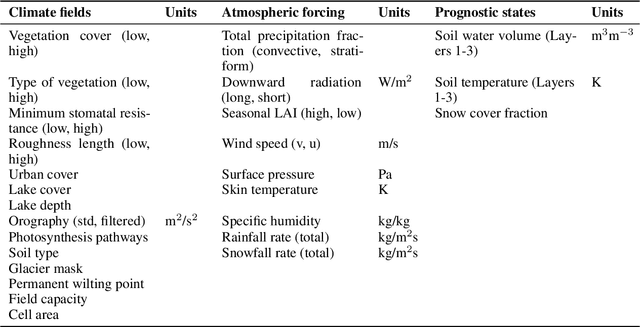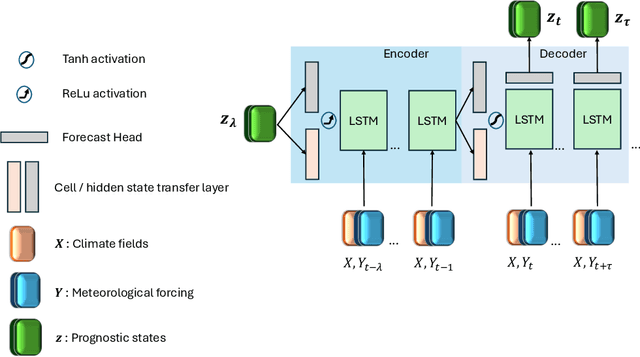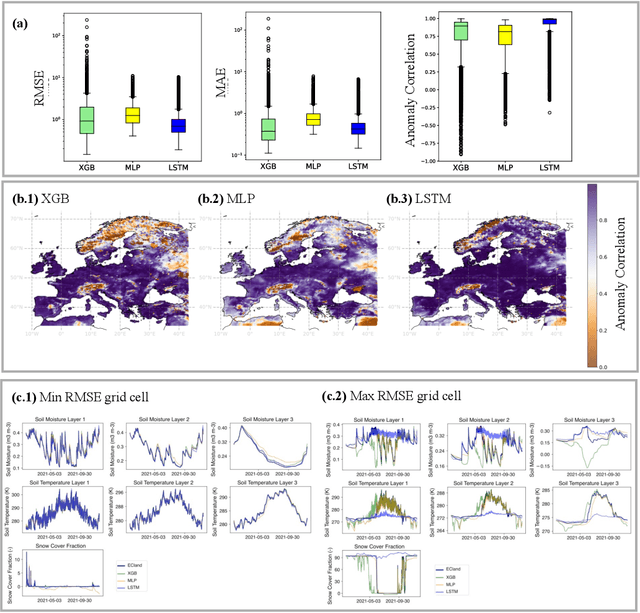Maria Kalweit
Advances in Land Surface Model-based Forecasting: A comparative study of LSTM, Gradient Boosting, and Feedforward Neural Network Models as prognostic state emulators
Jul 23, 2024



Abstract:Most useful weather prediction for the public is near the surface. The processes that are most relevant for near-surface weather prediction are also those that are most interactive and exhibit positive feedback or have key role in energy partitioning. Land surface models (LSMs) consider these processes together with surface heterogeneity and forecast water, carbon and energy fluxes, and coupled with an atmospheric model provide boundary and initial conditions. This numerical parametrization of atmospheric boundaries being computationally expensive, statistical surrogate models are increasingly used to accelerated progress in experimental research. We evaluated the efficiency of three surrogate models in speeding up experimental research by simulating land surface processes, which are integral to forecasting water, carbon, and energy fluxes in coupled atmospheric models. Specifically, we compared the performance of a Long-Short Term Memory (LSTM) encoder-decoder network, extreme gradient boosting, and a feed-forward neural network within a physics-informed multi-objective framework. This framework emulates key states of the ECMWF's Integrated Forecasting System (IFS) land surface scheme, ECLand, across continental and global scales. Our findings indicate that while all models on average demonstrate high accuracy over the forecast period, the LSTM network excels in continental long-range predictions when carefully tuned, the XGB scores consistently high across tasks and the MLP provides an excellent implementation-time-accuracy trade-off. The runtime reduction achieved by the emulators in comparison to the full numerical models are significant, offering a faster, yet reliable alternative for conducting numerical experiments on land surfaces.
CellMixer: Annotation-free Semantic Cell Segmentation of Heterogeneous Cell Populations
Dec 01, 2023


Abstract:In recent years, several unsupervised cell segmentation methods have been presented, trying to omit the requirement of laborious pixel-level annotations for the training of a cell segmentation model. Most if not all of these methods handle the instance segmentation task by focusing on the detection of different cell instances ignoring their type. While such models prove adequate for certain tasks, like cell counting, other applications require the identification of each cell's type. In this paper, we present CellMixer, an innovative annotation-free approach for the semantic segmentation of heterogeneous cell populations. Our augmentation-based method enables the training of a segmentation model from image-level labels of homogeneous cell populations. Our results show that CellMixer can achieve competitive segmentation performance across multiple cell types and imaging modalities, demonstrating the method's scalability and potential for broader applications in medical imaging, cellular biology, and diagnostics.
L(M)V-IQL: Multiple Intention Inverse Reinforcement Learning for Animal Behavior Characterization
Nov 23, 2023Abstract:In advancing the understanding of decision-making processes, mathematical models, particularly Inverse Reinforcement Learning (IRL), have proven instrumental in reconstructing animal's multiple intentions amidst complex behaviors. Given the recent development of a continuous-time multi-intention IRL framework, there has been persistent inquiry into inferring discrete time-varying reward functions with multiple intention IRL approaches. To tackle the challenge, we introduce the Latent (Markov) Variable Inverse Q-learning (L(M)V-IQL) algorithms, a novel IRL framework tailored for accommodating discrete intrinsic rewards. Leveraging an Expectation-Maximization approach, we cluster observed trajectories into distinct intentions and independently solve the IRL problem for each. Demonstrating the efficacy of L(M)V-IQL through simulated experiments and its application to different real mouse behavior datasets, our approach surpasses current benchmarks in animal behavior prediction, producing interpretable reward functions. This advancement holds promise for neuroscience and psychology, contributing to a deeper understanding of animal decision-making and uncovering underlying brain mechanisms.
Robust Tumor Detection from Coarse Annotations via Multi-Magnification Ensembles
Mar 29, 2023Abstract:Cancer detection and classification from gigapixel whole slide images of stained tissue specimens has recently experienced enormous progress in computational histopathology. The limitation of available pixel-wise annotated scans shifted the focus from tumor localization to global slide-level classification on the basis of (weakly-supervised) multiple-instance learning despite the clinical importance of local cancer detection. However, the worse performance of these techniques in comparison to fully supervised methods has limited their usage until now for diagnostic interventions in domains of life-threatening diseases such as cancer. In this work, we put the focus back on tumor localization in form of a patch-level classification task and take up the setting of so-called coarse annotations, which provide greater training supervision while remaining feasible from a clinical standpoint. To this end, we present a novel ensemble method that not only significantly improves the detection accuracy of metastasis on the open CAMELYON16 data set of sentinel lymph nodes of breast cancer patients, but also considerably increases its robustness against noise while training on coarse annotations. Our experiments show that better results can be achieved with our technique making it clinically feasible to use for cancer diagnosis and opening a new avenue for translational and clinical research.
 Add to Chrome
Add to Chrome Add to Firefox
Add to Firefox Add to Edge
Add to Edge